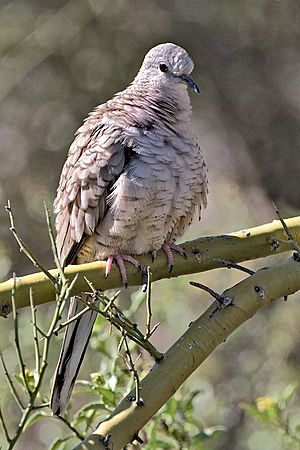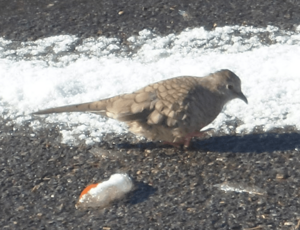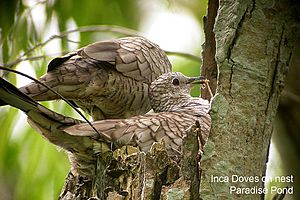Inca dove facts for kids
Quick facts for kids Inca dove |
|
|---|---|
 |
|
| Conservation status | |
| Scientific classification | |
| Genus: |
Columbina
|
| Species: |
inca
|
 |
|
| Synonyms | |
|
Scardafella inca |
|
The Inca dove or Mexican dove (Columbina inca) is a small New World dove. It was first described by a French scientist named René Lesson in 1847.
These doves are about 16.5 to 23 centimeters (6.5 to 9 inches) long. They usually weigh between 30 and 58 grams (1 to 2 ounces). Their wingspan is about 28.5 to 32 centimeters (11 to 12.5 inches).
Inca doves are slender birds with gray-brown feathers. Their feathers have a pattern that looks like scales. They have a long, square tail with white feathers on the edges. These white feathers can spread out when the bird flies. The feathers under their wings are reddish, just like other doves that live on the ground. When they take off, their wings make a quiet, rattling sound.
Where They Live and Their Home
The Inca dove lives in many places, from Costa Rica in the south to the American Southwest in the north. You can often find many of them in areas they like. Over the past few decades, they have been spreading their range both north and south.
Even though they are called "Inca doves," these birds do not live in the lands where the ancient Inca Empire once was. They are expanding their territory in both northern and southern directions. These birds spend a lot of time on the ground. They form groups in deserts, scrublands, and farmed areas. You can also find them in cities and towns. They eat grass seeds and drink water that comes from farms and suburban watering systems.
Inca doves have been seen in Florida, USA. However, it is not clear if they are having babies there. They might only be there because some birds escaped or were set free.
Nesting and Reproduction
Inca doves build their nests mostly in trees and bushes. Their nests are usually about 5 centimeters (2 inches) wide. The male dove collects most of the things needed for the nest. He brings them to the female, who also helps gather some materials.
The nest is made of small twigs, grass, plant stems, and leaves. Over time, the nest gets stronger because the baby birds' waste helps to reinforce it. These doves often use the same nest many times. One nest was even used 11 times!
Behavior

In winter, Inca doves gather together to stay warm. They huddle in a special pyramid shape. This helps them save heat. Up to 12 birds can be in one of these pyramids.
They often fly in groups outside their usual areas. These groups can have as many as 100 birds.
Their Voice
The Inca dove has a strong cooing sound. It sounds like cowl-coo or POO-pup. They often make this sound from a high spot. This could be a tree, a wire, or even a television antenna.
Inca dove species account at Neotropical Birds (Cornell Lab of Ornithology)
See also
In Spanish: Tortolita mexicana para niños



